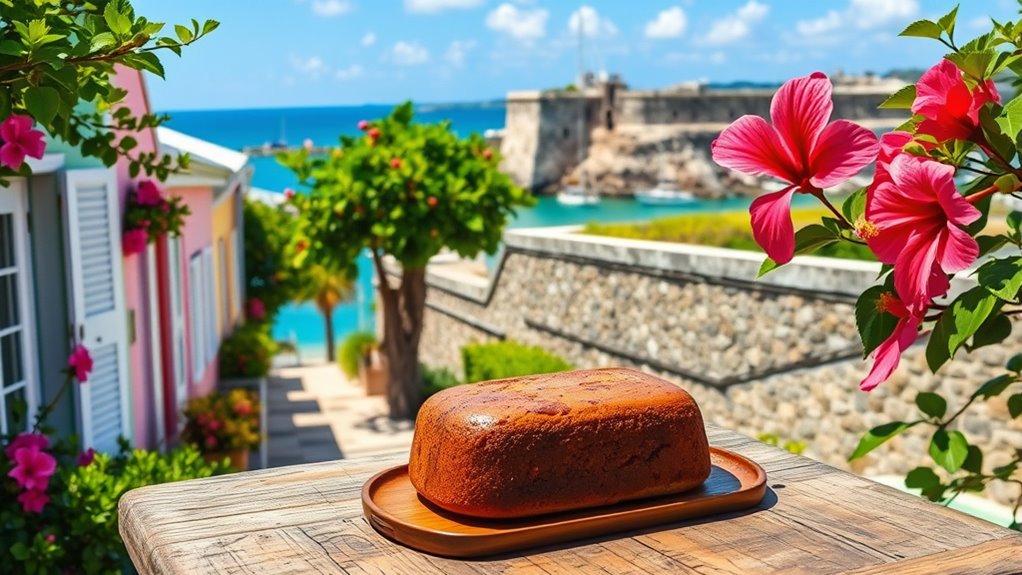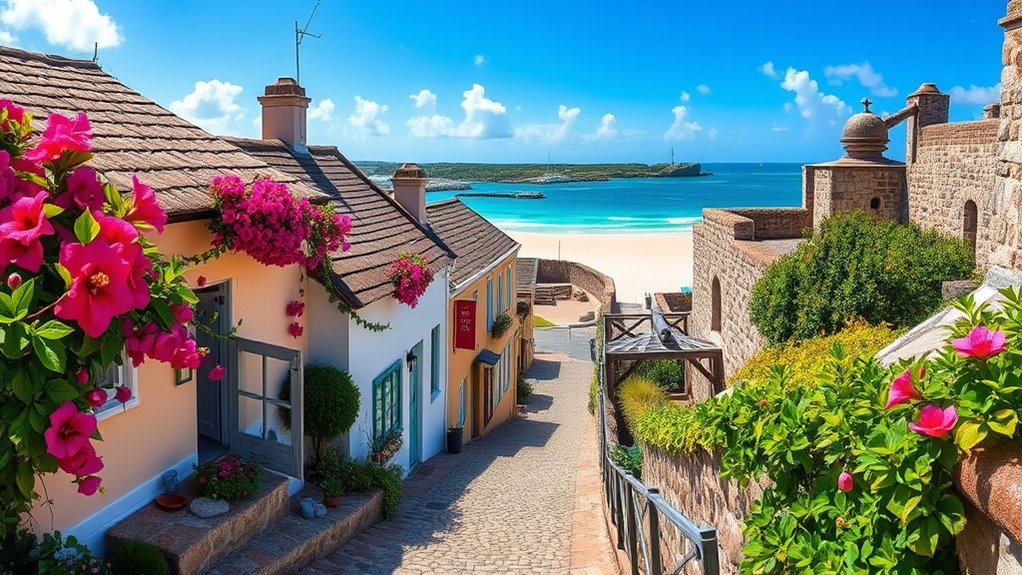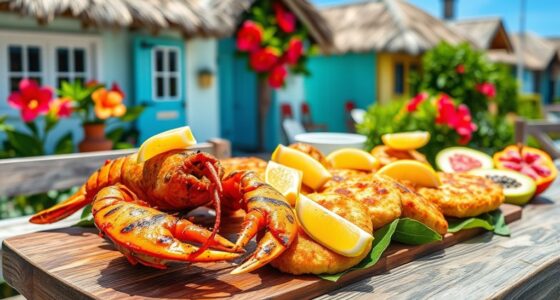Bermuda’s history begins with early explorers like Juan Bermúdez, followed by the 1609 shipwreck that brought Europeans, shaping its maritime importance. The island’s culture reflects African roots, British influence, and Caribbean heritage, seen in music, festivals, and traditions. Its political scene dates back to 1620, emphasizing self-governance while maintaining ties to Britain. From historic sites to stunning beaches, Bermuda’s diverse legacy offers a vibrant story of exploration, resilience, and cultural blending—discover more about its fascinating past and present.
Key Takeaways
- Bermuda’s history begins with early exploration by Spanish sailors and its strategic maritime importance to the British Royal Navy.
- The island’s cultural heritage reflects African, British, Indigenous, and Caribbean influences, preserved through music, dance, festivals, and traditions.
- Bermuda’s political development includes the oldest continuous parliament (established in 1620) and self-governance since 1957.
- Historic sites like St. George’s Town and shipwrecks highlight Bermuda’s maritime legacy and underwater archaeological significance.
- Tourism and conservation efforts showcase Bermuda’s natural beauty, maritime history, and diverse cultural attractions.
Early Exploration and Settlement

Did you know that Bermuda was first documented by Spanish explorers before it became part of the British colonial world? In 1511, Spanish navigator Juan Bermúdez charted the island, calling it “La Bermuda.” However, it wasn’t until 1609 that the English arrived, after the *Sea Venture* shipwrecked on Bermuda’s reefs. Three sailors stayed behind, becoming the first European settlers. By 1612, Bermuda was included in the Virginia Company’s charter, and St. George’s was established as the first town. The island’s strategic location and natural harbors made it a crucial maritime hub. Bermuda’s early history reflects a mix of exploration, survival, and colonization, laying the foundation for its future as a significant British territory in the Atlantic.
The Era of Slavery and Its Legacy

The legacy of slavery deeply shaped Bermuda’s history and its people, beginning with the arrival of the first enslaved Africans in 1616. You’ll see that slavery was essential to Bermuda’s economy and society, with laws restricting enslaved people’s freedoms. Several rebellions challenged this oppressive system between 1656 and 1761. In 1834, the British Emancipation Act freed enslaved Bermudians, but its effects linger today. About 60% of Black Bermudians descend from West African and West Indian ancestors brought during slavery. The table below shows key ideas about Bermuda’s slavery history:
| Event | Impact | Legacy |
|---|---|---|
| Arrival of first slaves | Economic foundation | Racial heritage |
| Slave rebellions | Resistance and unrest | Cultural resilience |
| Emancipation in 1834 | End of slavery | Ongoing racial dynamics |
| African ancestry | Cultural influence | Identity and heritage |
| Laws restricting enslaved | Control and suppression | Historical memory |
Additionally, the preservation of cultural resilience helps Bermudians maintain a connection to their ancestral roots and shared history.
Political Development and Governance

Bermuda’s political landscape has evolved considerably over the centuries, transforming from early colonial governance to a modern system that balances local autonomy with its status as a British Overseas Territory. You’ll find that Bermuda’s first parliament, established in 1620, is the oldest continuous parliamentary body in the Commonwealth. Over time, the island shifted from administering under the Virginia Company and the Somers Isles Company to becoming a Crown Colony in 1684. Self-governance was attained in 1957, giving Bermuda a degree of independence while remaining under British sovereignty. Today, Bermuda operates as a parliamentary democracy with an elected House of Assembly and a Senate, guided by a Governor appointed by the British Crown. This structure ensures local representation while maintaining the connection to Britain’s constitutional framework. Understanding governance is essential to appreciate Bermuda’s political evolution and current democratic processes.
Cultural Diversity and Heritage

You can see Bermuda’s rich cultural diversity through its African roots, British influences, and Indigenous and Caribbean heritage. These elements blend together, shaping the island’s traditions, music, and community life today. Recognizing this mix helps you understand Bermuda’s unique identity and vibrant history. Additionally, the island’s cultural influences continue to evolve, reflecting ongoing interactions among these diverse heritages.
African Cultural Roots
African cultural roots deeply influence Bermuda’s identity, especially through the descendants of enslaved Africans brought during the 17th century. You can see this influence in the island’s music, dance, and oral traditions, which bear the marks of West African rhythms and storytelling styles. Many Bermudians of African descent maintain cultural practices that connect them to their ancestral heritage, such as spirituals and communal celebrations. These traditions have blended with British and Caribbean influences, creating a unique cultural tapestry. You’ll also find African-inspired art and cuisine woven into everyday life. The resilience of these cultural roots reflects a history of struggle, survival, and adaptation, shaping Bermuda’s social fabric and reinforcing the importance of heritage in its collective identity. Additionally, the preservation of traditional cultural practices continues to play a vital role in maintaining these ancestral connections.
British Influences Persist
British influences are deeply woven into Bermuda’s cultural fabric, shaping its traditions, institutions, and everyday life. You’ll notice this in Bermuda’s legal system, which follows British common law, and its parliamentary structure, the oldest in continuous use within the Commonwealth. British customs, such as afternoon tea and cricket, remain popular social activities. Education systems, government operations, and official language also reflect British heritage. The island’s architecture, from colonial-style buildings to historic forts, echoes its colonial past. To deepen your understanding, see the table below:
| Aspect | Influence | Example |
|---|---|---|
| Legal System | British common law | Court procedures |
| Cultural Practices | British customs | Cricket, afternoon tea |
| Architecture | Colonial design | St. George’s historic buildings |
Additionally, Bermuda’s heritage preservation efforts help maintain and celebrate its British colonial architecture and traditions.
Indigenous and Caribbean Heritage
Have you ever wondered how Bermuda’s diverse cultural tapestry reflects its indigenous roots and Caribbean connections? You’ll find that Bermuda’s history includes early influences from Native Americans and West Africans brought through the Atlantic slave trade. Although the island’s indigenous peoples largely vanished, their legacy persists in local folklore and traditions. The African diaspora, forcibly brought to Bermuda, plays a central role in shaping its cultural identity, evident in music, dance, and community practices. Caribbean influences entered through migration, trade, and shared history, blending with British and maritime traditions. This mix creates a vibrant, multicultural society where indigenous, African, and Caribbean heritages intertwine. Today, Bermuda’s cultural diversity is celebrated through festivals, music, and cuisine, reflecting a rich tapestry rooted in resilience and connection. Additionally, the influence of home theatre projectors on modern entertainment spaces demonstrates how technological integration enriches cultural experiences.
Maritime Significance and Strategic Role

Bermuda’s reefs and strategic location made it a vital naval base for the British Royal Navy, shaping its military history. Key shipwreck events, like the *Sea Venture* disaster, highlight its importance in navigation and maritime challenges. Its position in the Atlantic has long linked it to global trade routes and colonial expansion efforts.
Naval Base History
Did you know that Bermuda’s strategic location in the Atlantic made it a pivotal naval and maritime hub for centuries? Its proximity to major shipping routes meant control of the island offered significant military advantages. Over time, Bermuda’s naval history deepened with key developments:
- It hosted British naval bases that protected Atlantic trade and colonial interests.
- The Royal Navy used Bermuda’s reefs for both defense and training purposes.
- During wartime, Bermuda’s bases served as critical staging points for Atlantic operations.
- The island’s fortifications and dockyards reinforced its role as a strategic naval stronghold.
- The importance of Bermuda’s military significance was further solidified through ongoing strategic deployments and infrastructure investments.
This naval presence shaped Bermuda’s military significance, making it indispensable to British maritime dominance and regional security efforts across the Atlantic.
Key Shipwreck Events
Bermuda’s reefs have long been both a navigational hazard and a catalyst for historic shipwrecks that shaped the island’s maritime legacy. The most famous is the *Sea Venture* in 1609, which wrecked near Bermuda’s reefs, leading to the colony’s founding and inspiring Shakespeare’s *The Tempest*. Over centuries, countless ships, including treasure galleons, merchant vessels, and military ships, have run aground here, earning Bermuda a reputation as the “Shipwreck Capital of the Atlantic.” These wrecks contributed to local economy and wayfinding knowledge, prompting the development of underwater archaeology and tourism. Some wrecks still lie beneath the waters, serving as historic sites and artificial reefs that support marine life. The frequent shipwrecks underscore Bermuda’s strategic maritime importance and the hazards sailors faced steering the Atlantic. Holistic health approaches have also been incorporated into the preservation efforts to promote the well-being of divers and researchers exploring these sites.
Strategic Atlantic Position
Why was Bermuda considered a vital strategic hub in the Atlantic? Its location made it a key point for navigation, trade, and military operations. Bermuda’s reefs protected ships, while its position allowed control over Atlantic routes. The island served as a crucial naval base for the British Royal Navy, safeguarding maritime interests. Its position connected North America, the Caribbean, and Europe, influencing colonial expansion and trade networks. Bermuda’s strategic role included: 1. Navigation Aid: Its reefs guided ships safely through dangerous waters. 2. Defense Outpost: Served as a military stronghold protecting Atlantic approaches. 3. Trade Center: Acted as a link in transatlantic trade routes. 4. Territorial Influence: Named territories and islands as explorers and settlers expanded into the Americas. This strategic significance shaped Bermuda’s history and ongoing maritime importance. Additionally, the island’s jet boat capabilities exemplify advancements in maritime technology, highlighting its importance in navigation and defense.
Transition to Modern Bermuda

How did Bermuda evolve into the modern territory it is today? You see, Bermuda’s progression began with its shift from early colonial roots to self-governance in 1957, granting locals more control over their affairs. The move from St. George’s to Hamilton in 1815 reflected economic and administrative changes, shaping its urban landscape. Over time, Bermuda developed a stable democracy, maintaining its status as a British Overseas Territory while enjoying significant autonomy. Its economy diversified beyond maritime activities to tourism and international finance, driven by its rich history and strategic location. Preservation of historic sites, like St. George’s Town, alongside modern infrastructure, helped forge a unique identity. Additionally, the integration of data-driven marketing strategies has played a role in promoting Bermuda as a premier destination. Today, Bermuda balances its deep historical roots with contemporary developments, creating a resilient, thriving society rooted in its complex past.
Bermuda’s Cultural Attractions and Tourism

The rich history and diverse cultural heritage of Bermuda form the foundation of its vibrant tourism industry today. You can explore historic sites like St. George’s Town, a UNESCO World Heritage Site that showcases colonial architecture and maritime history. Bermuda’s museums offer insights into its African influences and naval past. The island’s natural beauty, including pink-sand beaches and coral reefs, attracts divers and sunbathers alike. To deepen your understanding, consider these aspects:
Explore Bermuda’s colonial sites, vibrant museums, and pristine beaches to experience its rich history and natural beauty.
- Visit historic landmarks like Fort St. Catherine and the Bermuda Maritime Museum.
- Experience local culture through festivals such as Bermuda Day and Carnival.
- Discover environmental conservation efforts at the Bermuda Aquarium and Zoo.
- Engage with Bermuda’s multicultural community to appreciate its African, British, and Caribbean influences.
These attractions create a rich tapestry that draws visitors worldwide.
Frequently Asked Questions
How Did Bermuda Influence Atlantic Maritime Navigation and Shipwreck Lore?
You see, Bermuda greatly influenced Atlantic maritime navigation and shipwreck lore through its reefs, which posed both hazards and navigational markers. Sailors relied on Bermuda’s reefs to chart courses, but they also often wrecked on them, fueling stories and legends like the Bermuda Triangle. These shipwrecks helped develop navigational techniques and contributed to maritime lore, making Bermuda a key point in Atlantic shipping history and a symbol of maritime mystery.
What Role Did Bermuda Play in the Transatlantic Slave Trade?
You might think Bermuda was just a remote island, but it played a crucial role in the transatlantic slave trade. As ships charting the Atlantic, traders used Bermuda’s reefs as a navigational marker, often stopping there to resupply and enslave Africans and Native Americans. With over 60% of Black Bermudians descending from enslaved West Africans, Bermuda was a key hub in this dark chapter of history.
How Has Bermuda’s Political Autonomy Evolved Within the British Commonwealth?
You see that Bermuda’s political autonomy has grown steadily within the British Commonwealth. You’ve witnessed its shift from being governed by companies like the Virginia and Somers Isles to becoming a Crown Colony in 1684. Today, you recognize Bermuda as a self-governing British Overseas Territory, operating with significant independence since 1957. Its government manages local affairs, while Britain retains control over defense and foreign relations, balancing autonomy with its colonial heritage.
In What Ways Does Bermuda’s African Heritage Shape Its Contemporary Culture?
You can see Bermuda’s African heritage in its vibrant cultural expressions, music, and dance, which reflect West African traditions. You might notice the influence in local festivals, storytelling, and crafts that honor ancestors and history. The Black community’s resilience and history of slavery and emancipation deeply shape Bermuda’s identity, fostering a strong sense of pride and continuity. This heritage influences everything from cuisine to social customs, enriching Bermuda’s diverse cultural landscape.
What Are the Origins of Bermuda’s Unique Administrative Division Into Nine Parishes?
You might find it interesting that Bermuda’s nine parishes were formed from its early administrative structure, originally divided by the Virginia and Somers Isles Companies. These companies named eight parishes after their shareholders, reflecting their influence on the island’s development. When Bermuda became a Crown Colony in 1684, this division into nine parishes persisted, shaping local governance and community identity that continues today.
Conclusion
Your journey through Bermuda’s rich history reveals a tapestry woven with resilience and vibrant culture. Like a lighthouse guiding ships through stormy seas, its enduring spirit shines brightly today, inviting you to explore its treasures. From early explorers to modern marvels, Bermuda’s story is a declaration to perseverance and diversity. Embrace its heritage, and let it inspire your own voyage of discovery, where every wave echoes with the legacy of this remarkable island.










